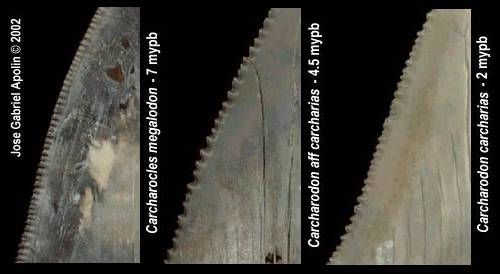The evolution of a cutting-edgeJim Bourdon ©2002I doubt there is a better location to observe the transition of the hastalis tooth-design to that of carcharias than the Pisco Formation of southern Peru. Extensive exposures between the cities of Pisco and Lomas have provided unparalleled specimens, many of which have been 'smuggled' to the collector's market. Despite a lack of funding, the Laboratorio de Paleontología de Vertebrados Universidad Peruana Cayetano Heredia Lima - Peru is attempting to study and retain these specimens for science. As is always the case in these matters, it is local 'pickers' that find the specimens driven by their need to survive (financially). It can only be hoped that the important specimens end-up in the museums and the only the lesser examples work their way to the open market. Jose Gabriel Apolin has been studying this fauna, particularly the development of the Great Whites for a number of years. He has agreed to share a few images and his experience for this project. It should be pointed out that this page does not reflect his opinion, some of which differs from the author's. (Readers are also free to interpret this evidence as they like.) The central point from the author's perspective is the evolution of the teeth, not the names ascribed to them. Do these teeth, ranging from 8 to 2 mybp reflect the evolution of a single tooth-design? (Comparative dentition-design are on the Cosmopolitodus genus page.) Accepting this transition would override the megalodon-carcharias lineage argument, which might not be possible for all. The evolution in design, as reflected by the teeth in the below images, provides the keystone for additional discussion. Unlike the megalodon-origins viewpoint, which pre-supposes a speciation event in some unknown place and time, the hastalis-carcharias transition is gradual, and largely centered in the Pacific. From a biological perspective, it is most likely that a single species is represented by these tooth-designs. The fossil record however only provides chrono-snapshots that have traditionally been ascribed to separate species and even genera.
In current literature, these four teeth would normally (but not in all cases) be ascribed (from left to right) to Isurus hastalis (a.k.a. xiphodon), I. escheri, Carcharodon aff carcharias and C. carcharias. Narrow-form Cosmopolitodus hastalis (AGASSIZ, 1843) — Mid-Late Miocene of Peru
Ten years ago, there would have been minimal disagreement on the genus name for this tooth-design. However, during this period, evidence of a great white lineage for these teeth (rather than mako) has grown. Those viewing these "broad-toothed makos" as ancestral great whites, had the choice of using Glikman's (1964) genus Cosmopolitodus or Carcharodon (LINNAEUS, 1758), for these teeth. This author prefers the usage of the chrono-genus Cosmopolitodus however acknowledges that full morphological evidence, if available, would probably support Carcharodon. Broad-form Cosmopolitodus hastalis (a.k.a. xiphodon) — Late Miocene of PeruThe first tooth measures 6.5 cm and is from the Aguada de Lomas level at Aguada de Lomas; these sediments are thought to date from 7-9 mybp. Teeth of the general hastalis design have been separated into several design groups: hastalis (narrower/ chronologically older teeth), xiphodon (by Purdy (1996) for the broader/chronologically younger), escheri (serrate) and planus (distally curved). As with the genus, there are arguments that these should all be synonymized to a single species (hastalis). I again prefer using the morpho-species rather than lumping these (often regionalized) designs into a single bucket. How confusing it would be if all these tooth-designs were referred to by a single name (Carcharodon carcharias). 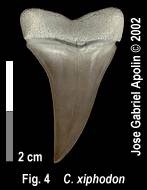
Cosmopolitodus planus (AGASSIZ, 1856)Kemp (1991) included planus as present in the Late Oligocene (Jan Juc Fm., Victoria) of Australia - the earliest published occurrence of this tooth-design. It has been reported from Miocene faunas of Australia (Early-Middle), Japan (Mid-Late) and California. Although a Pacific morpho-species, the 'typical' planus tooth-design hasn't been reported from Peru. Jose Apolin (pers. comm. 2001) suggests that this might be attributable to the age of the Pisco deposits. He does note that distally curved xiphodon teeth are relatively common. Broad-form Cosmopolitodus hastalis with serrations — Late Miocene of PeruThe second tooth measures 5.1 cm and is also from Aguada de Lomas, but the Montemar level. The sediments that produced this specimen are thought to date from about 6 mybp. It is a serrate, broad-form hastalis-type tooth, which would traditionally be ascribed to Isurus escheri (AGASSIZ, 1843). Mikael Siverson (pers. com. 2001) was the first to point out to me that escheri appeared to be a European species with its own dentition-design. Although weakly serrate teeth are found on both sides of the Atlantic and Pacific, their overall dentition-design is not similar to escheri. Teeth with a similar cutting-edge have also been reported from the Senahata Formation (Late Miocene) of Japan (Yabe & Hirayama 1998 as C. carcharias). Kemp (1991) reported C. carcharias from Grange Burn Frm., Victoria (Late Miocene - Early Pliocene), it is unclear from the condition of these specimens whether or not they bear the weakly or strongly serrate cutting-edge. I prefer to use the morpho-genus/species hastalis (broad-form, a.k.a. xiphodon) for these weakly serrate teeth from the Pacific and Western Atlantic — mainly for clarity. I would suspect that Hideo is technically correct calling these teeth carcharias. Carcharodon aff. carcharias — Early Pliocene of PeruThe third tooth measures 4.0 cm and is from the South-Sacaco level at Aguada de Lomas. These sediments date to 4.5 mybp. The serrations are much more developed but still quite weak, lacking the robust characteristic of the extant species. This would appear to be a Pacific-based tooth-design. This design is also known from an articulated dentition, see: Sacaco Great White ?Mako. In Peru, this design is also present in the Sacaco level (c3.9 mybp). Carcharodon carcharias (LINNAEUS, 1758) — Late Pliocene of PeruThe fourth tooth measures 5.4 cm and is from an unpublished zone at Sacaco. These deposits date to approximately 2 mybp. These teeth clearly represent the tooth-design of the extant great white. A Carcharocles Connection?It is difficult to end this discussion without considering the place of the megatoothed shark, Carcharocles megalodon (AGASSIZ, 1837), in this cutting-edge evolution. Well, there seems to be little room to fit meg into this transition. Poorly developed and irregular serrations were last seen within this lineage during the Ypresian (early Eocene) when the morphospecies, C. aksuaticus (MENNER, 1928) (see: Otodus-Carcharocles Segue), appeared throughout the Tethys. There seems to be few similarities between the small homogeneous serrations on the Carcharocles cutting-edge and those that developed on Carcharodon.
AcknowledgementsSpecial thanks to Jose Gabriel Apolin for sharing his research and providing the much needed images. Ongoing thanks are extended to David Ward and Mikael Siverson for sharing their considerable knowledge with a ray guy. Review CommentsBoth Mikael Siverson and David Ward reviewed the content of this page. They made several comments which have been incorporated within the text. References
| ||||||||||||||||||
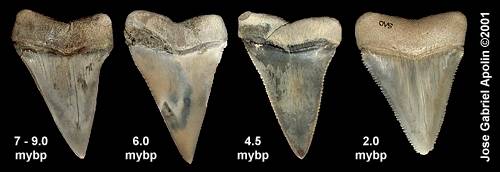
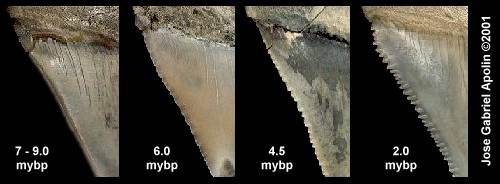
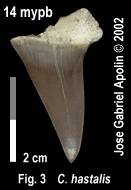 Not represented in the above images is the more narrowly defined hastalis-type tooth-design. In Peru, this design is primarily known from the El Jahuay Level of the Pisco which dates to approximately 9-10 mybp. Jose Apolin (pers. comm. 2001) noted that he has encountered an hastalis specimen that came from 14 mybp sediments.
Not represented in the above images is the more narrowly defined hastalis-type tooth-design. In Peru, this design is primarily known from the El Jahuay Level of the Pisco which dates to approximately 9-10 mybp. Jose Apolin (pers. comm. 2001) noted that he has encountered an hastalis specimen that came from 14 mybp sediments.